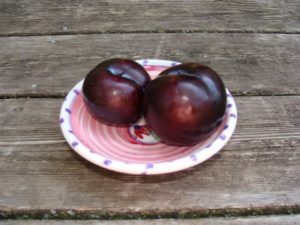One of the things I love most about Chinese medicine is the poetic names they have for funky conditions and illnesses. Shingles are called Snake Cinnabar Toxin, cystic zits are Clove Sores, simultaneous vomiting and diarrhea is Sudden Turmoil, and a yeast infection is called Fire in the Valley or Damp Heat in the Lower Burner. One of their most descriptive and poetic names is something called Plum Pit Qi, which is a term to describe the sensation of a chronic lump in your throat.
In my clinic, I see a number of people with Plum Pit Qi. They describe this lump as the feeling of something being caught at the bottom of their throat that won’t go away no matter what they do. The lump can be mild, and mentioned only  when I ask, or it can be so severe that it will limit a sufferer’s diet. For some people, certain foods seem to aggravate the feeling, among them meat, onions, acidic foods, and alcohol. In every case, the sufferer is under a lot of stress or is trying to deal with difficult life circumstances.
when I ask, or it can be so severe that it will limit a sufferer’s diet. For some people, certain foods seem to aggravate the feeling, among them meat, onions, acidic foods, and alcohol. In every case, the sufferer is under a lot of stress or is trying to deal with difficult life circumstances.
One of the most severe cases of Plum Pit Qi that I have seen in the clinic affected Maureen*, a professional woman in her early forties. She had been coming to me off and on for a couple of years. Maureen began to experience the sensation of a lump after receiving some upsetting news about a sibling. As she worried about her family member, the symptoms became worse. At one point the lump in her throat was so severe that she was unable to eat any solid food for several weeks.
What exactly is going on when you have the sensation of a lump in your throat? In most cases, it’s a spasm of one of the muscles of your esophagus brought on by stress. Sometimes, however, it can have a physical origin such as a throat infection, being overweight or esophageal reflux. Difficulty swallowing can also be the sign of a more serious condition, and should be checked out by your doctor if it lasts for more than a week or two.
In Chinese medicine, this lump is called Plum Pit Qi because it feels like a plum pit is caught in your throat. The Chinese believe that Plum Pit Qi is the result of a situation that is figuratively too hard to swallow, so it gets caught in your throat and won’t budge. That’s why I know that the patients I see with this condition are also struggling with some kind of stressful life event or issue.
Plum Pit Qi is a diagnosis that encompasses a Liver and Spleen disharmony combined with phlegm. A disharmony between the Chinese Liver and Spleen, in general, means that your energy is stagnating (usually emotional energy) and beginning to mess up your digestion. In Chinese medicine, phlegm can be both visible (what you see when you blow your nose or cough) and invisible. Invisible phlegm can be the result of energy stagnating combined with poor fluid metabolism, and is the cause of many lumps and bumps in your body. Things like goiters, tumors, and cysts can be considered invisible phlegm.
In the clinic, Plum Pit Qi can be successfully and naturally treated. I like to combine acupuncture with Chinese herbs for this condition. The formula Ban Xia Hou Po Tang is formulated specifically for Plum Pit Qi, is safe, and works incredibly well. Self care for Plum Pit Qi includes tracking the foods that aggravate your symptoms, and working on resolving stress, anxiety, and the situations in your life that are too difficult to swallow.
In Maureen’s case, after consulting with her medical doctor, she chose to treat her Plum Pit Qi with Chinese medicine. We combined acupuncture, an herbal formula, dietary therapy, and stress relief measures to alleviate her symptoms. Within a week or two, Maureen began to eat small amounts of solid food, and over the period of a month or so, she was able to get back to eating normally without feeling a lump at all.
*Names and identifying details have been changed.



